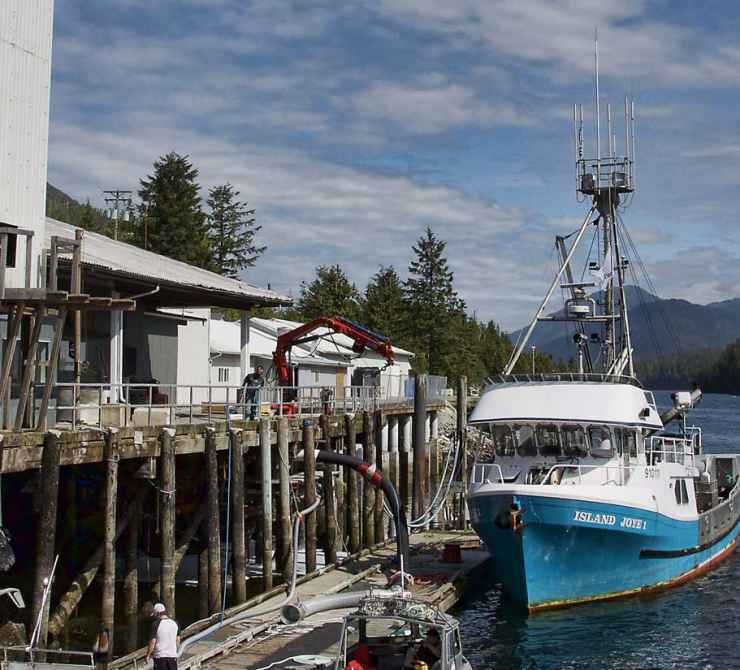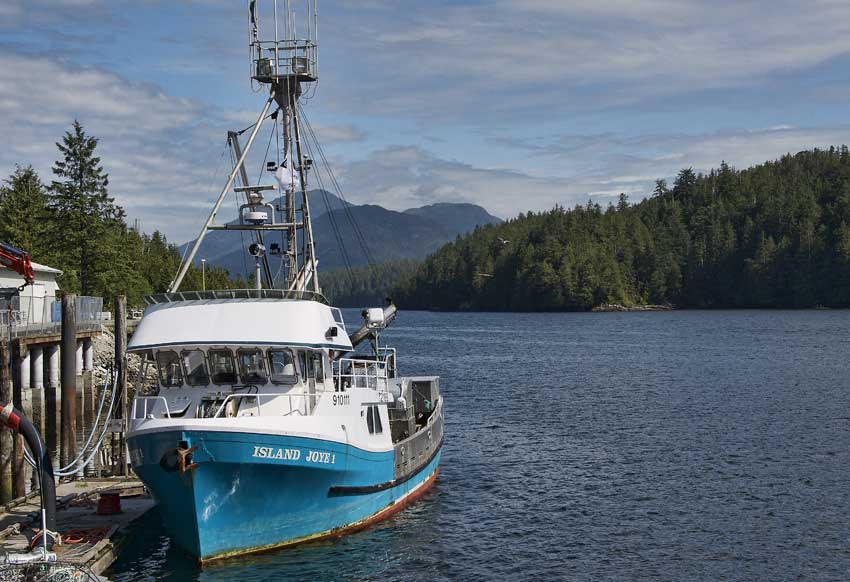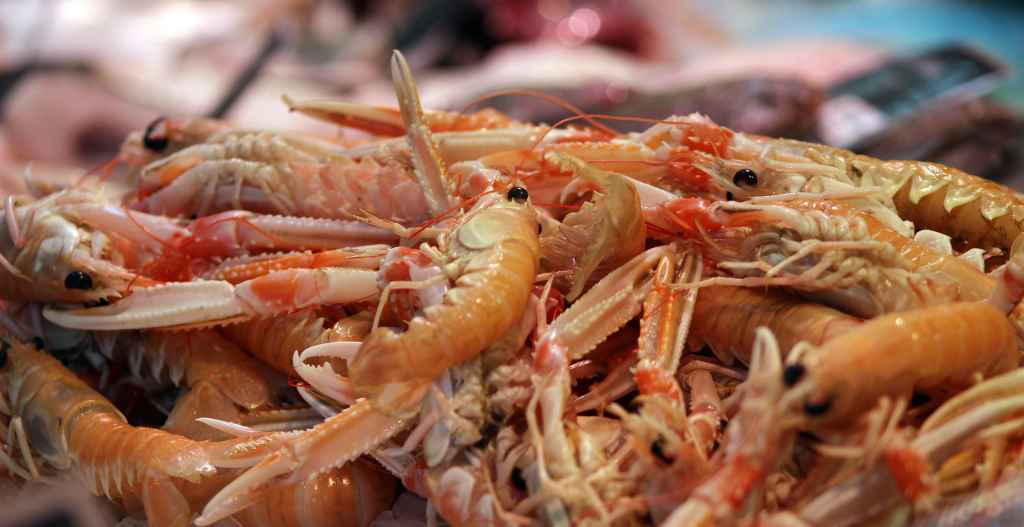In BC's remote Central Coast, the Kitasoo Xai'xais Nation is supporting the local economy with its community-owned seafood company.
Kitasoo Seafoods: Bringing a Local Harvest to an International Market
Estimated Reading time

12 Mins

Klemtu
Located in BC’s remote Central Coast, Kitasoo Seafoods is one of the largest employers in the community of Klemtu. This community is only accessible by boat or float plane.
At a Glance
The Kitasoo/Xai’xais Nation is situated in one of the most remote and isolated communities on the West Coast of Canada. Kitasoo Seafoods has been a pillar of employment and industry in the community since 1985, with more than one person from every household working at the organization.
In 2012, the Nation identified an opportunity to increase the capacity of the business and diversify their market exposure by developing high-value seafood products. The Nation invested in the expansion of infrastructure to allow Kitasoo Seafoods to be able to process their own products and increase both profit margins and product quality.
Diversifying and Increasing Sustainability

Kitasoo Seafoods has been operating for over 30 years. The business initially processed wild seafood, but due to wild species processing not being economically viable in their existing facility and a lack of access to commercial licenses, in 2000 Kitasoo Seafoods transitioned its operations to focus on farmed salmon.
That changed in 2012 as Kitasoo Seafoods gradually expanded to include wild species again. In an effort to offer more sustainable, locally harvested seafood and to enter a specialized international market, the company expanded with a new arm of the business called Kitasoo Seafoods Wild. This business arm focuses on highly valued wild species, including sea cucumbers, spawn-on-kelp, prawns, and wild salmon.
The Canadian Food Inspection Agency (CFIA) closely regulates the processing of seafood products and has strict criteria for the layout of seafood plants that process multiple species. To satisfy CFIA regulations and expand processing operations, Kitasoo Seafoods increased capacity by acquiring specialized equipment and upgrading their existing facilities into a second processing plant. With this investment, Kitasoo Seafoods now has two distinct registered plants, allowing it to process the additional species.
Larry Greba, Director of Kitasoo Development Cooperation, explains: “We designed the expansion by looking at the different species that we anticipated that we get involved in. This included species we were already processing, such as sea cucumbers and spawn-on-kelp, but also the other ones that had a lot of potential.” This change meant the business could also process new species with higher profit margins, such as live prawns.
Creating High-Value Seafood Products
To target high-end Asian markets with specialized wild species, including prawns and sea cucumbers, new methods for delivering and processing products had to be implemented.

“We learned that there was demand in Asia for a live delivery method of transporting prawns. This means taking them live to the plant and then packing them in the plant, rather than the traditional way of quick freezing prawns on the vessels and then shipping them,” explains Greba. “In the end, we are essentially doing the same thing, but now we have better quality control by doing the processing in the plant as opposed to the people on the boat doing it.”
In addition to increasing quality control, keeping prawns alive until processing retains their freshness and quality for longer, which increases their value. “When you kill a prawn, they deteriorate very quickly. Freezing them live and quickly at very low temperatures retains the quality of the product much longer,” explains Greba. “Further, there’s a huge demand in the Japanese market for whole prawns with the head on, so it’s a win-win change.”
Another potential opportunity was to start processing wild chum, a species of salmon often overlooked for its lower market value. Thinking strategically, management realized the potential to process this product with a higher margin. “We actually saw a lot of opportunity with this wild salmon,” says Greba. “Chums can be really valuable, not so much for their meat, but for their roe. That’s still a very highly valued product with a Japanese market primarily.”
In order to process these new products, an overhaul of procedural operations had to be completed to accommodate CFIA regulations. A detailed quality management plan had to be prepared, specifying how products are stored and how they move through the plant for processing. “You need an excellent Quality Management Plan in place for a seafood plant,” advises Greba. “It is how the CFIA measures you. You need to show the procedure for each product through the plant. That takes time to develop.”
A Community Model for Business

The ultimate goal of Kitasoo Seafoods is to operate through market shifts and provide stable employment opportunities for the community of Klemtu. Ben Robinson, Chief Executive Officer of the Kitasoo Development Corporation has been involved in Kitasoo Seafoods since its beginning in 1985. “The hope for the business when we started it 30 years ago was to provide employment for people here” he says. “It was always the dream for the community.”
Following this original vision, the recent expansion to include additional species and add primary processing capacity increases the resiliency of the business and, by extension, local livelihoods. “The expansion into Kitasoo Seafoods Wild creates the diversification we need and gives us an opportunity to weather industry changes,” says Greba.
Although salmon processing remains a mainstay of many coastal economies, Kitasoo Seafoods’ management recognizes that salmon stocks can be variable and that a year of reduced runs could be devastating to a salmon-reliant business. The seafood industry is also prone to fluctuations in available species stocks and shifts in market value. This can leave seafood businesses exposed to market and environment changes, and is in part what motivated the expansion.
Our mantra for development is to keep an even-keeled approach to the seafood industry and responsibility to the community.
“We took a look at what we were doing and decided our focus was too narrow,” explains Robinson. “The industry is constantly shifting, and what is available and what has higher profit margins changes over time.” The move to diversify the species caught and processed by Kitasoo Seafoods helps mitigate this risk. “We want to build other opportunities beyond a single species. Otherwise the business and those we employ become very vulnerable,” explains Greba. “Out mantra for development is to keep an even-keeled approach to the seafood industry and responsibility to the community.”
Key Challenges and Successes
Creating a Specialized Community Workforce
Maintaining a labour force in Klemtu that is certified to work in a processing plant under CFIA regulations has been, and remains, a significant challenge. Given the remote and isolated placement of the community, it is difficult and costly to hire contractors for technical training and to retain staff. “The human resource challenge of running a business in a remote community is not to be underestimated,” says Greba. “It’s our challenge in everything we do.”
In an effort to mitigate this, Kitasoo Seafoods is working to create the expertise needed for the plant in its existing worker and community member base by recruiting locally and providing training opportunities. “There is a lot of mentoring in past years as people become trained for processing the new products,” says Greba.
This approach to foster the required skills in-house has been working. “In the past we’ve brought in processors to work with us, and they come in and bring the expertise, and have helped with everything,” says Greba. “But last year, we were pretty much doing it on our own — we only had one person come in from outside and provide us support.”
That one of their main challenges is staffing is also an upside, says Greba. “It means there is employment for almost anyone who wants it in the community. We are proud of the opportunities we provide.”
An Evolving Model
Greba also believes Kitasoo Seafood’s unique business approach contributes to its success. “There are different approaches you can take to seafood businesses, like higher volumes of production for lower value product. Alternatively, there is a low volume, higher value product model, which is what we do,” says Greba. By specializing in products with higher profit margins, the plant is able to hone in on specific markets and create high quality, highly valued products.
“It can be scary to take the next step from fishing into processing, but the results are worth it,” says Greba. “It’s like anything. It is a leap. But if you are careful, and if you start small, it’s amazing what doors will open. And if you make the effort to take the leap, as opposed to being afraid and sticking to the lowest common denominator of what you can do, and instead take the opportunity you have and take initiative — it’s incredible what can happen.”
Economic Outcomes
Kitasoo Seafoods and Wild Fisheries provide significant employment and support to the local economy. A Coast Funds’ award of $660,000 supported infrastructure investment, including increased cold storage capacity in the second plant, increased accommodations for workers, and a refit of a commercial seine fishing vessel to support the expansion of Kitasoo Seafoods to process wild products.
Learn more about infrastructure investment.
Cultural Outcomes
The inclusion of diverse wild species maintains a cultural connection to saltwater foods that were traditionally harvested by the Nation, such as spawn-on-kelp. “My people were saltwater people. We were always harvesting from the sea” says Robinson. By not focusing on and over-harvesting a single species, the expanded plant supports the diversity of the local marine environment and helps to maintain traditional foods used for food, social, and ceremonial purposes for future generations.
Learn more about traditional foods.
Environmental Outcomes
Sustainability and the impact of the operations on the environment and future generations underpin all decisions made at Kitasoo Seafoods. “We look forward in everything we do with the plant,” says Robinson. “It is not enough to just be focused on expanding and generating revenue. The long term impact of operations has to be a factor.”
The Central Coast has extremely limited processing capacity and this project enables the community to manage wild resources in line with their stewardship initiatives and marine use plan, rather than have products be shipped to outside processors from Vancouver or elsewhere.
Social Outcomes
The expansion of Kitasoo Seafoods into wild fisheries provides significant employment opportunity in the local community. There were 21 full time jobs created as part of this initiative and staff retention in the community was also improved.
Kitasoo Seafoods also provides training opportunities for local staff to build their skill set and increase employability, including certification to work in CFIA-regulated facilities.
Learn more about skills training.
In 2012, Coast Economic Development Society approved $660,000 towards this project.
Online Resources
- True to Their Visions: An Account of 10 Successful Aboriginal Businesses.
Conference Board of Canada Report – 2009. - Kitasoo Xai’xais – Integrated Maine Use Plan.
2011. - Kitasoo Community Vision.
Sylix Business Profile, Kitasoo Seadfoods LP. - Community Profile: Kitasoo/Xai’Xais First Nation.
Fisheries and Oceans Canada Nation Profile. - Marine Harvest Wharfside
McColl Magazine Article. - Marine Harvest and Kitasoo/Xai’xais Mark Ten Years of Partnership in Klemtu.
Nation Talk Release, 2008. - First Nations on Fish Farms: Two Perspectives.
Northword Magazine, 2006. - BC Aquaculture Industry.
Seafood Business Assessment. - Is the Mysterious Sea Cucumber Slipping Out of Our Grasp?
Smithsonian Magazine, November, 2017.
Published On May 15, 2016 | Edited On April 1, 2025


